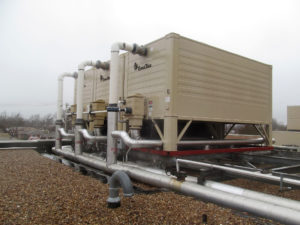 What’s lurking in your traditional open cooling tower basin? Today, there is a growing concern about the sediment build-up, algae growth, and bacteria growth in open cooling tower basins. If these are among your concerns why not look at a tower with a different design.
What’s lurking in your traditional open cooling tower basin? Today, there is a growing concern about the sediment build-up, algae growth, and bacteria growth in open cooling tower basins. If these are among your concerns why not look at a tower with a different design.
Who Says You Need a Tub of Water as Your Cooling Tower Basin?
There is a cooling tower design that does not require a flat collection area with stagnant or low-velocity points. In the video below, you will see how flow through basin design works. This design eliminates the large sediment and growth collection areas and keeps the velocity of the exiting water well above traditional towers.
Let’s look at a short video:
Notice the water keeps moving. The water is simply channeled to the outlet of the tower. If you were designing a tower today and were concerned with the issues of storing water in the cooling tower basins, wouldn’t you start channeling the water also? You might want to keep that water moving at over 5 feet per second.
This channel with a higher velocity will keep any sediment from sitting or collecting on the bottom of your tower basin. The water with the suspended dirt is flowing out of the tower and into the system. Now a Griswold sediment separator properly installed in the piping system can remove the dirt. Look at this previous Monday Morning Minutes.
 You May Want to Look at Tower Tech
You May Want to Look at Tower Tech
Controlling the flow velocity in supply water from the cooling tower is only one advantage of this tower. There are many other reasons to consider.
- A multiple fan system that saves electrical energy over traditional designs and provides built-in redundancy.
- Lower water makeup results in water conservation and lower water bills
- Higher cycles of concentration mean less chemical used and less money spent on chemicals.
- Lower maintenance required means lower maintenance costs.
- The secret contractors want to keep from their competitors…much lower time of installation.
Did I get your attention? Contact your R. L. Deppmann sales representative by phone, email, or just clicking here.
Next week, we turn to our plumbing engineer audience and look at examples of using the Bell & Gossett System Syzer to calculate pump head for sewage pump applications.

